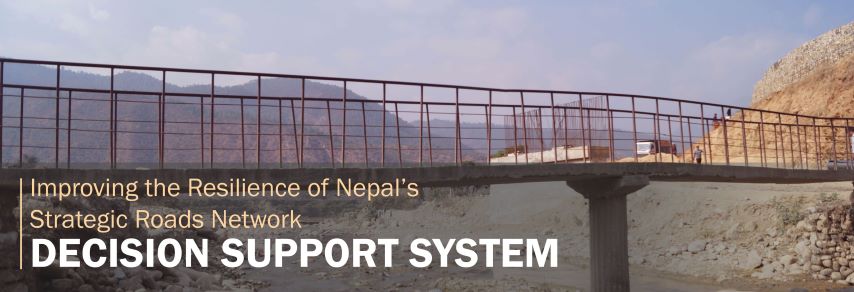
The purpose of the Decision Support System (DSS) is to support The World Bank and the Nepal Department of Roads in prioritising investments in strategic road infrastructure across Nepal. The DSS integrates hydrological, seismic, climate and socio-economic data and information to identify sites of highest vulnerability to climate and seismic threats.
The geographical scope of the project is the eight road corridors which are targeted by the Road Sector Development Project (RSDP) and Nepal-India Regional Trade and Transport Project (NIRTTP).
Summary of road corridors assessed in project
| No | Road Name | Total length (km) | Number of bridges |
|---|---|---|---|
| 1 | Chinchu-Jajarkot Road | 108 | 17 |
| 2 | Khodpe-Chainpur Road | 101 | 6 |
| 3 | Satbanj-Darchula Road | 110 | 14 |
| 4 | Satbanj-Tripurasundari Road | 7 | 0 |
| 5 | Sitalpati-Musikot Road | 82 | 10 |
| 6 | Surkhet-Jumla Road | 207 | 21 |
| 7 | Tallodungeshwor-Dailekh Road | 25 | 3 |
| 8 | Narayanghat-Mugling Road | 36 | 15 |
Risk Zoning Map
Risk Mitigation Options
Metadata records
Summary of Risk Value:
Applied Mitigation Options
About the project
The resilient infrastructure project is implemented through three interconnected components:
Component I: “Hazard Mapping and Risk Assessment” was implemented by Aviyaan Consulting Private Limited. It focused on the collection and consolidation of geohazard risk information, made available through an online platform;
Component II: ‘Improving the Resilience of Nepal’s Strategic Roads Network’, is implemented by the Joint Venture of International Centre for Environmental Management (ICEM) Asia and GEOCE Consultants Private Limited; and
Component III: “Geohazard Risk Management Investment Plan”, is being implemented by EPTISA, which is carrying out in-depth design and implementation of resilient road measures for the identified roads under the RSDP and NIRTTP;